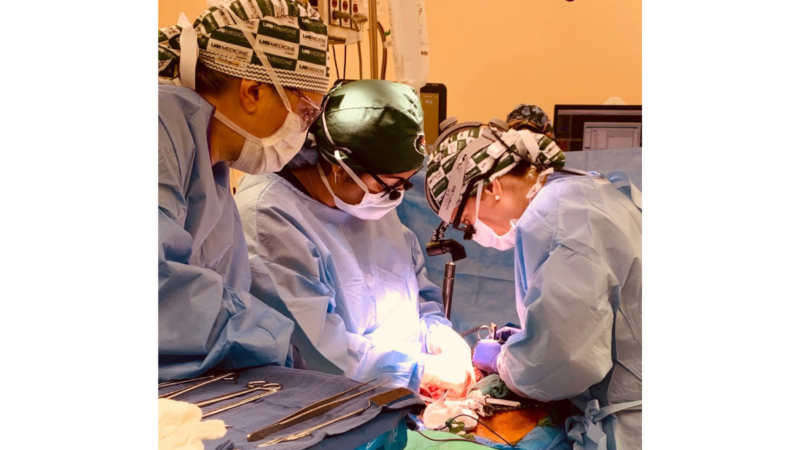UAB surgeons transplant pig kidneys into a human body for the first time
A team of scientists at the University of Alabama at Birmingham is the first to successfully transplant the kidneys of a genetically modified pig into the body of a brain-dead recipient.
The surgery, which took place last September, is detailed in a peer-reviewed article published Thursday in the American Journal of Transplantation.
Upon being transplanted into the human recipient, researchers said the pig kidneys turned pink, and one began to make urine after 23 minutes.
“That is what every transplant is supposed to do, and it was amazing,” said Dr. Jayme Locke, director of UAB’s Comprehensive Transplant Institute and lead surgeon for the study.
The study lasted 77 hours before the recipient was taken off of life support. During that time, the kidneys appeared to function, though one produced more urine than the other, and there were no signs of immediate organ rejection. Additionally, no pig viruses or pig cells were detected in the recipient’s body.
The research is the latest milestone in the field of xenotransplantation and the first time that such a surgery has been described in a peer-reviewed journal.
Locke is hopeful that genetically modified pig organs will one day provide a life-saving solution for thousands of people who die every year waiting for a kidney transplant.
“They have a disease that we have a cure for, but we don’t have enough and we need a radical solution,” Locke said. “We have to find an alternative organ source, and xenotransplantation, I believe, is the answer.”
Locke said UAB’s research will likely be key to gaining approval from the U.S. Food and Drug Administration for a Phase 1 clinical trial, which researchers hope to begin later this year.
The study answered several questions about the viability of genetically modified pig kidneys inside the human body. It also demonstrated a new model of testing research on a brain-dead recipient.
Scientists hope to name the model they tested after the individual in the study, 57-year-old Jim Parsons, who was fatally injured in a motorcycle accident last year.
Parsons’ family, who consented to the research, described him as a compassionate father who sought adventure and was always willing to help.
“Our greatest hope is that this study … will ultimately bring new life to hundreds of thousands of people in the United States and around the world in need of a kidney transplant,” said Parsons’ ex-wife Julie O’Hara. “We’re forever honored that Jim’s gift has an opportunity to give those in need a chance at life.”

Many questions remain about the process of xenotransplantation, but scientists hope it could be an option for patients in the coming decade.
Last fall, surgeons at NYU Langone Health attached a genetically modified pig kidney to the outside of a brain-dead recipient’s leg. Earlier this month, surgeons in Maryland completed the first successful transplant of a pig heart into a living recipient.
EDITOR’S NOTE: UAB holds WBHM’s broadcast license, but our news and business departments operate independently.
More immigration judges are being fired amid Trump’s efforts to speed up deportations
Several more immigration judges have been fired, even as the Trump administration ramps up immigration enforcement, and after Congress gave the Department of Justice $3 billion, in part to hire judges.
Why the health care lobby failed to stop cuts to Medicaid funding
The powerful health industry lobby couldn't persuade GOP lawmakers to oppose big Medicaid cuts in President Trump's tax and spending bill. What's behind the lobbying failure?
South Africa’s president creates commission to look at police corruption allegations
South Africa's President Cyril Ramaphosa has suspended the police minister and launched a sweeping inquiry into alleged sabotage at the highest levels of law enforcement..
Wrongly convicted, he became ‘The Jailhouse Lawyer’ — and helped free himself
While serving a life sentence for a murder he was eventually exonerated of committing, Calvin Duncan studied law and helped many wrongfully convicted prisoners. His memoir is The Jailhouse Lawyer.
Through comics, ‘Essex County’ creator shows us the struggles, triumphs of his career
Jeff Lemire explores his career arc, the road to successfully delivering Essex County and other comics to the public, in a new graphic memoir.
Trump announces weapons for Ukraine and threatens Russia with tariffs
President Trump threatened to punish Russia with heavy tariffs on countries that trade with Moscow if the Kremlin fails to reach a ceasefire deal with Ukraine, while promising Kyiv weapons.








